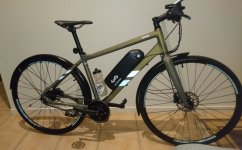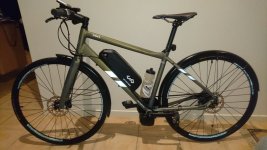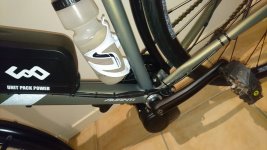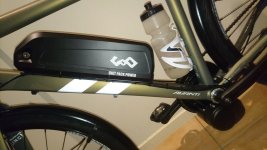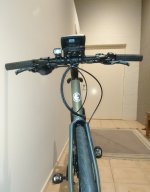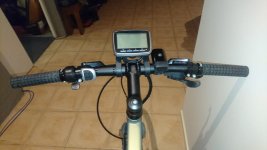casainho
10 GW
- Joined
- Feb 14, 2011
- Messages
- 6,045
Here you can see the options that users will be able to configure on our OpenSource firmware for TSDZ2:
- Different throttle modes:
-- torque sensor Human Power mode (torque * PAS)
-- torque sensor plain signal only
-- PAS mode but with starting up using torque sensor signal
- max pedal cadence value
- assist levels multiplication factor
- battery pack from 7S up to 14S, for indication of battery state of charge on LCD and also protection of battery undervoltage: firmware quickly stops drawing battery current when the VLC voltage is hit
- max battery current (controller max possible value if 16 amps)
- step rate of increasing PWM duty-cycle: will help to get a slow increase of motor torque and so protect the plastic blue gear
- tweaking motor max efficiency torque per amp (this may give only smaller improvement)
- support for 2 different LCDs: TSDZ2 LCDs and Kunteng LCD3 (LCD5 also) that is more complete like can show motor usage power in real time, battery voltage, etc.
None of this features are not yet implemented on our firmware for TSDZ2 but all of that is implemented already for our firmware running on Kunteng motor controllers and should be very easy to put working on TSDZ2 -- here is the configuration file and the options:
- Different throttle modes:
-- torque sensor Human Power mode (torque * PAS)
-- torque sensor plain signal only
-- PAS mode but with starting up using torque sensor signal
- max pedal cadence value
- assist levels multiplication factor
- battery pack from 7S up to 14S, for indication of battery state of charge on LCD and also protection of battery undervoltage: firmware quickly stops drawing battery current when the VLC voltage is hit
- max battery current (controller max possible value if 16 amps)
- step rate of increasing PWM duty-cycle: will help to get a slow increase of motor torque and so protect the plastic blue gear
- tweaking motor max efficiency torque per amp (this may give only smaller improvement)
- support for 2 different LCDs: TSDZ2 LCDs and Kunteng LCD3 (LCD5 also) that is more complete like can show motor usage power in real time, battery voltage, etc.
None of this features are not yet implemented on our firmware for TSDZ2 but all of that is implemented already for our firmware running on Kunteng motor controllers and should be very easy to put working on TSDZ2 -- here is the configuration file and the options:
Code:
/*
* TongSheng TSDZ2 motor controller firmware/
*
* Copyright (C) Casainho, 2018.
*
* Released under the GPL License, Version 3
*/
#ifndef CONFIG_H_
#define CONFIG_H_
// This file is the firmware configuration for the TSDZ2 motor controller,
// to run the 2 different available motors of 36V or 48V motor,
// and from 24V battery (7S) up to 52V battery pack (14S).
// *************************************************************************** //
// THROTTLE
//
// choose between following modes. You can choose for instance TORQUE_SENSOR_AND_THROTTLE and if you have
// throttle connected, the output signal used to control the motor will be the max value of both torque sensor or throttle
#define EBIKE_THROTTLE_TYPE EBIKE_THROTTLE_TYPE_TORQUE_SENSOR_AND_THROTTLE
//#define EBIKE_THROTTLE_TYPE EBIKE_THROTTLE_TYPE_PAS_AND_THROTTLE
//#define EBIKE_THROTTLE_TYPE EBIKE_THROTTLE_TYPE_THROTTLE_ONLY
// next, choose one of the both (only apply to throttle and/or PAS)
//#define EBIKE_THROTTLE_TYPE_THROTTLE_PAS_PWM_DUTY_CYCLE // direct PWM duty_cycle control, important for developers
#define EBIKE_THROTTLE_TYPE_THROTTLE_PAS_CURRENT_SPEED // control using motor current/torque and/or wheel speed
// next, if enabled, output of torque sensor algorithm is the human power (torque * cadence) other way will be the same as the torque signal
// (only apply to torque sensor)
#define EBIKE_THROTTLE_TYPE_TORQUE_SENSOR_HUMAN_POWER
// PAS configurations
// MAX cadence, where the output value of PAS processiing will be the max value
#define PAS_MAX_CADENCE_RPM 90
// *************************************************************************** //
// *************************************************************************** //
// LCD
// the firmware supports the original LCD and the more complete Kunteng LCD3 and LCD5
#define LCD_TYPE LCD_TYPE_TSDZ2
#define LCD_TYPE LCD_TYPE_KUNTENG // shows battery voltage, motor real time usage power, etc
// you can tune LCD assist level
#define ASSIST_LEVEL_0 0.00
#define ASSIST_LEVEL_1 0.44
#define ASSIST_LEVEL_2 0.66
#define ASSIST_LEVEL_3 1.00
#define ASSIST_LEVEL_4 1.5
#define ASSIST_LEVEL_5 2.25
// *************************************************************************** //
// *************************************************************************** //
// BATTERY
// Choose your battery pack voltage
// the cells number can be a custom value from 7S up to 14S, choose the value of your battery pack
#define BATTERY_LI_ION_CELLS_NUMBER 7 // 7S = 24V battery pack
//#define BATTERY_LI_ION_CELLS_NUMBER 10 // 10S = 36V battery pack
//#define BATTERY_LI_ION_CELLS_NUMBER 13 // 13S = 48V battery pack
//#define BATTERY_LI_ION_CELLS_NUMBER 14 // 14S = 52V battery pack
// This is the current that motor will draw from the battery
// Higher value will give higher torque and the limit of the controller is 16 amps
#define ADC_BATTERY_CURRENT_MAX 224 // (14 ADC bits step per 1 amp) so, 224 for 16 amps
// Considering the follow voltage values for each li-ion battery cell
// State of charge | voltage
#define LI_ION_CELL_VOLTS_100 4.06 // this value is used to help finding the battery SOC
#define LI_ION_CELL_VOLTS_80 3.93 // this value is used to help finding the battery SOC
#define LI_ION_CELL_VOLTS_60 3.78 // this value is used to help finding the battery SOC
#define LI_ION_CELL_VOLTS_40 3.60 // this value is used to help finding the battery SOC
#define LI_ION_CELL_VOLTS_20 3.38 // this value is used to help finding the battery SOC
#define LI_ION_CELL_VOLTS_10 3.25 // this value is used to help finding the battery SOC
#define LI_ION_CELL_VOLTS_0 3.00 // this value is used to help finding the battery SOC and is the minimum value after which the firmware don't ask more current to battery, to run the motor
// *************************************************************************** //
// *************************************************************************** //
// MOTOR CONTROLLER
// Choose PWM ramp up/down step (higher value will make the motor acceleration slower)
//
// For a 24V battery, 25 for ramp up seems ok. For an higher voltage battery, this values should be higher
#define PWM_DUTY_CYCLE_RAMP_UP_INVERSE_STEP 25
#define PWM_DUTY_CYCLE_RAMP_DOWN_INVERSE_STEP 10
// *************************************************************************** //
// *************************************************************************** //
// MOTOR
// Choose some parameters for your motor (if you don't know, just keep the following original values because they should work ok)
//
// This value should be near 0.
// You can try to tune with the whell on the air, full throttle and look at batttery current: adjust for lower battery current
#define MOTOR_ROTOR_OFFSET_ANGLE 0
// This value is ERPS speed after which a transition happens from sinewave no interpolation to have
// interpolation 60 degrees and must be found experimentally but a value of 25 may be good
#define MOTOR_ROTOR_ERPS_START_INTERPOLATION_60_DEGREES 25
// *************************************************************************** //
#endif /* CONFIG_H_ */

